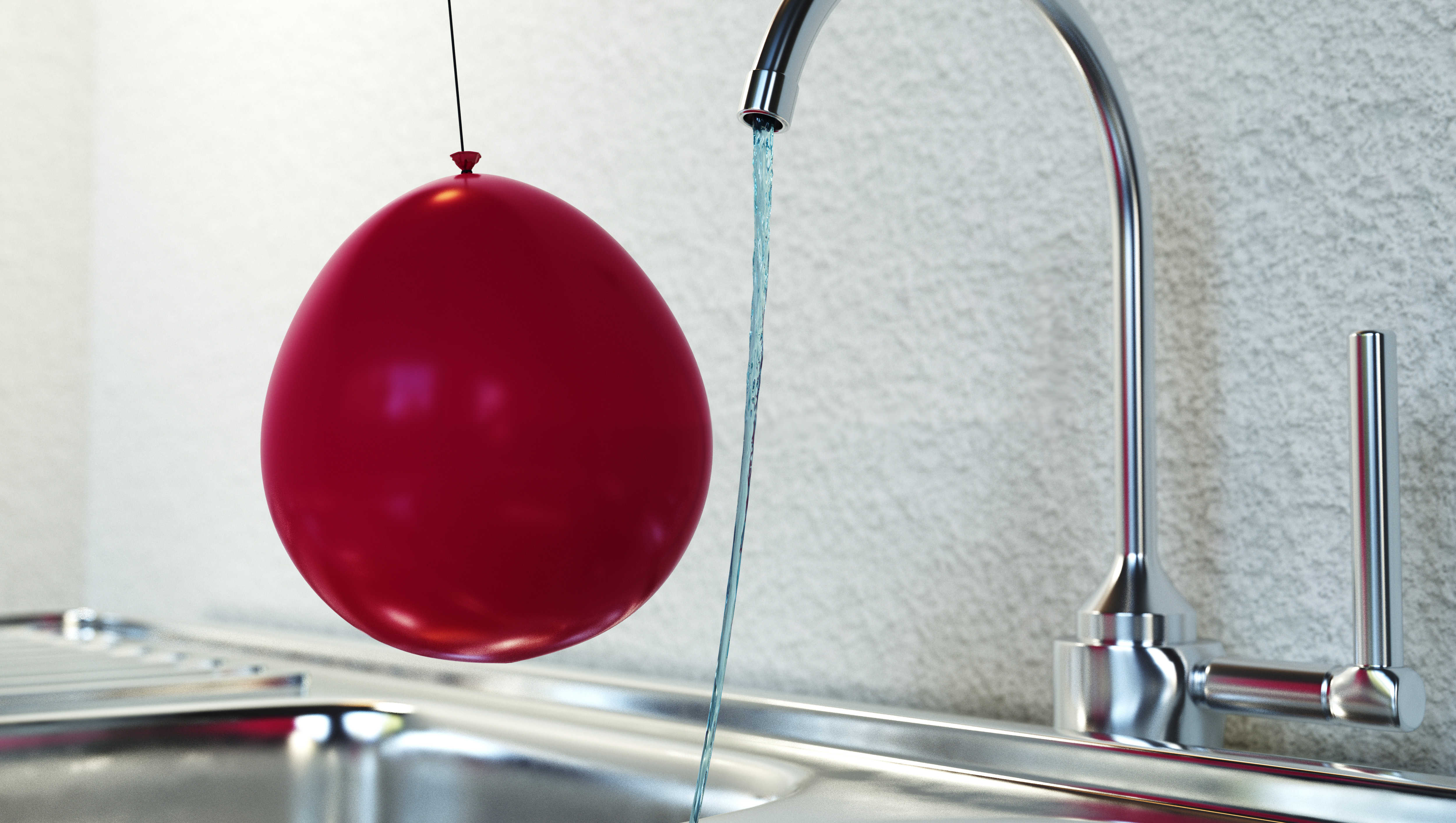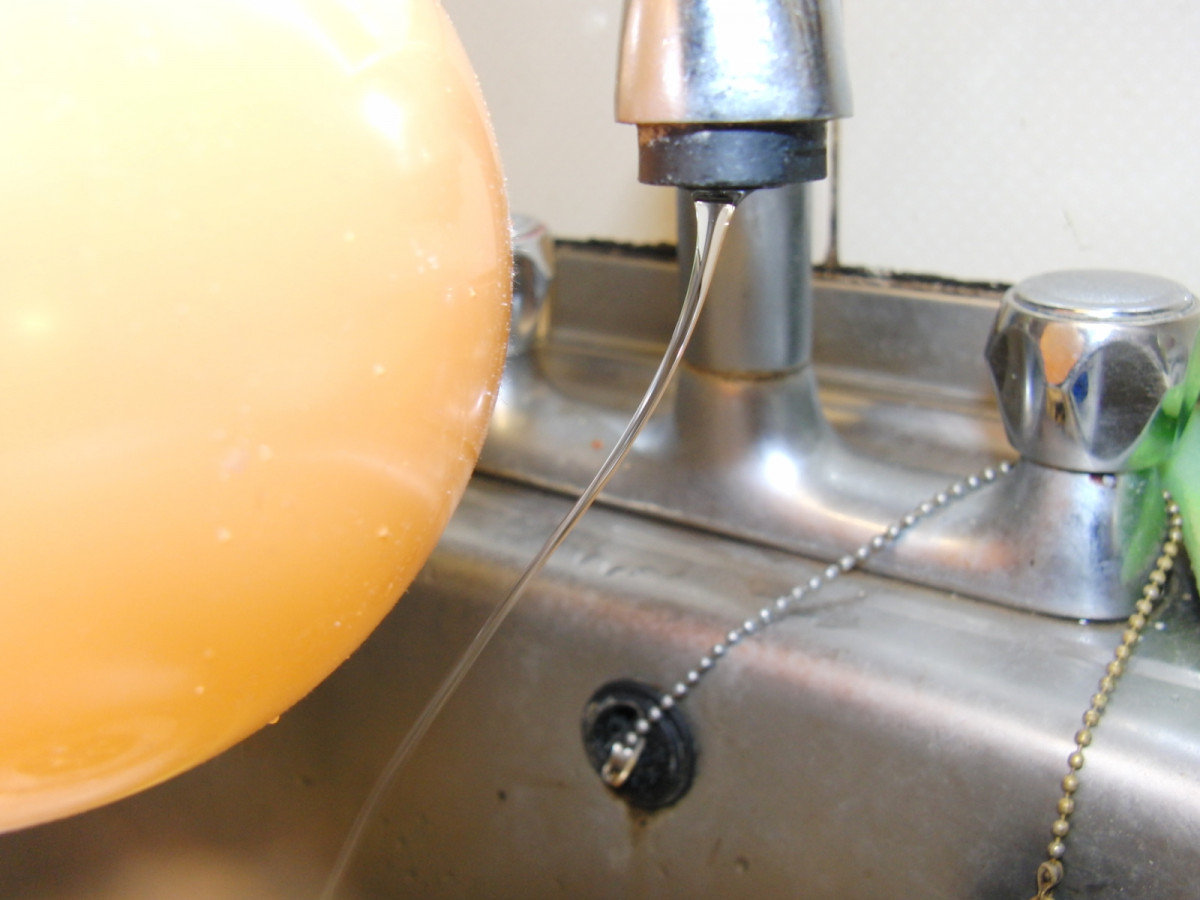Introduction
Why Does Water Bend Towards A Balloon: The bending of water towards a balloon is a fascinating phenomenon that occurs due to a combination of several factors. This intriguing behavior can be attributed to the principles of surface tension, adhesion, and the pressure differences created by the presence of the balloon. Understanding why water bends towards a balloon involves delving into these scientific concepts, which shed light on the forces at play and unravel the underlying physics behind this captivating occurrence. When water comes into contact with a solid surface like a balloon, surface tension plays a crucial role. Surface tension refers to the cohesive forces between water molecules at the liquid-air interface. These forces create a “skin” on the surface of the water, causing it to behave as if it has an elastic membrane.

In the case of a balloon, the surface tension of water causes it to cling to the balloon’s surface. This is due to the adhesive forces between the water molecules and the balloon material. As a result, the water forms a thin film that adheres to the balloon. At the same time, the presence of the balloon creates a pressure difference in the surrounding air. When the balloon is inflated, it displaces the air around it, creating a region of slightly higher pressure. This pressure difference leads to an imbalance of forces, with higher pressure pushing against the water film on one side of the balloon.
In response to this pressure difference, the water film on the side facing the balloon is compressed, while the water film on the other side remains relatively unaffected. As a result, the water film on the compressed side is pushed towards the balloon, causing it to bend or curve towards the balloon’s surface. This bending phenomenon can be observed more prominently when the balloon is filled with a larger volume of air, as it creates a greater pressure difference and consequently a stronger force acting on the water film.
Why does water bend towards a charged object?
Water is made up of polar molecules, each containing a negatively charged oxygen end and a positively charged hydrogen end. When a charged rod of material is brought near a thin stream of water, the water will be attracted to the charged rod and the stream of water will bend towards the rod. Water bends towards a charged object due to the phenomenon known as electrostatic attraction. This attraction is a result of the interaction between the charged object and the polar nature of water molecules.
Water molecules are composed of two hydrogen atoms and one oxygen atom, creating a bent structure with a slight negative charge near the oxygen atom and a slight positive charge near the hydrogen atoms. This polarity makes water a polar molecule. When a charged object, such as a positively or negatively charged rod, is brought close to water, it creates an electric field around itself. This electric field interacts with the polar water molecules.
If the charged object is positively charged, the negatively charged oxygen end of the water molecules is attracted to it. This electrostatic attraction causes the water molecules to align with the electric field generated by the charged object. As a result, the water surface bends towards the charged object. Similarly, if the charged object is negatively charged, the positively charged hydrogen ends of the water molecules are attracted to it. This electrostatic attraction again causes the water molecules to align with the electric field, resulting in the water surface bending towards the charged object. The strength of the electrostatic attraction depends on the magnitude and distance of the charge. The greater the charge and the closer the charged object is to the water, the stronger the bending effect will be.
What is the science behind water bending?
Water bending reacts to static electricity by focusing on the imbalances in an object’s positive and negative charges. The water stream holds a positive charge, while the objects hold a negative charge due to static electricity. An invisible force bends the water around the balloon. The science behind water bending involves several fundamental principles, including surface tension, adhesion, cohesion, and capillary action.
Let’s explore each of these principles:
Surface Tension: Surface tension refers to the cohesive forces between water molecules at the surface. Water molecules are attracted to each other, creating a “skin” or surface layer. This cohesive force causes the water surface to behave like a stretched elastic sheet. When an external force, such as the presence of an object, disrupts the surface tension, the water surface deforms and adjusts around the object.
Adhesion: Adhesion is the attraction between molecules of different substances. Water molecules have adhesive properties, allowing them to stick to other materials, such as glass, plastic, or a solid object like a balloon. This adhesion between water and a surface leads to water “wetting” or spreading on the surface, creating a thin film.
Cohesion: Cohesion refers to the intermolecular forces between water molecules themselves. These cohesive forces are responsible for the surface tension and the tendency of water molecules to stick together. The cohesive forces are stronger than the adhesive forces between water and certain materials, contributing to the formation of droplets or the curvature of water surfaces.
Capillary Action: Capillary action is the ability of a liquid to flow in narrow spaces or tubes against gravity. It occurs due to a combination of cohesive forces and adhesive forces. In the case of water, when it encounters a narrow space or a porous material, such as a capillary tube or fabric, the cohesive and adhesive forces cause the water to rise or bend in opposition to gravity.
Why does the stream of water bend toward the negatively charged balloon in the bottom photo?
Why does the stream of water bend toward the negatively charged balloon in the bottom photo? The electric force of the balloon pushes the negative part of the water molecules away, and the positive side is attracted to the balloon. In the case where the stream of water bends towards a negatively charged balloon, the phenomenon can be attributed to the principle of electrostatic attraction.
When the balloon is negatively charged, it acquires an excess of electrons, giving it a net negative charge. The negatively charged balloon creates an electric field around itself. Water is a polar molecule, with a slightly positive charge near its hydrogen atoms and a slightly negative charge near its oxygen atom. When the negatively charged balloon is brought close to the stream of water, the negative charges on the balloon repel the negative charges in the water molecules. As a result, the water stream becomes positively charged relative to the balloon.
Opposite charges attract each other, so the positively charged water stream is attracted to the negatively charged balloon. This electrostatic attraction between the oppositely charged objects causes the stream of water to bend towards the negatively charged balloon.
It’s important to note that this bending effect is a result of the interaction between the charged balloon and the charged water stream. The electrostatic forces at play overpower the influence of gravity and other forces on the water, causing it to deflect towards the charged object.
Why does water bend near electricity?
Water, which is two hydrogen atoms and one oxygen atom, also is made up of charged particles, with the two hydrogen atoms having a positive charge. Because in water’s liquid form these atoms are free to move around any which way, it can easily be affected by a static electrical charge. Water can bend near electricity due to the phenomenon of ionization and the resulting electric fields created by the flow of electric current.
When an electric current passes through a medium like water, it can cause ionization. Ionization refers to the process where neutral atoms or molecules gain or lose electrons, becoming positively or negatively charged ions. In the case of water, the process of ionization occurs, resulting in the formation of positively charged hydrogen ions (H+) and negatively charged hydroxide ions (OH-).
These charged ions in the water create an electric field around them. Electric fields exert forces on other charged particles or objects in their vicinity. When water is in the presence of an electric field, the water molecules can become polarized. The positive charges of the water molecules align themselves with the electric field, while the negative charges align in the opposite direction.
As a result of the polarization of water molecules, the electric field can exert a force on the water, causing it to bend or curve in the direction of the field. The magnitude and direction of the bending depend on factors such as the strength of the electric field, the concentration of ions in the water, and the distance from the source of electricity. It’s important to note that the bending of water near electricity is a transient effect and requires the presence of an electric field. Once the electric field is removed or the electric current ceases, the bending effect on water diminishes.

What scientific principles contribute to the bending of water towards a balloon?
The bending of water towards a balloon can be explained by several scientific principles, including surface tension, adhesion, and capillary action. Surface tension refers to the cohesive forces between water molecules at the surface. Due to these forces, water molecules tend to stick together, forming a kind of “skin” on the water’s surface. When a balloon is placed near the water, the surface tension of the water causes it to deform, creating a concave shape around the balloon.
Adhesion is the attraction between molecules of different substances. Water molecules have a strong adhesive force with the material of the balloon, such as rubber. This adhesive force between the water molecules and the balloon’s surface pulls the water towards the balloon, further contributing to the bending effect.
Capillary action is the ability of a liquid to flow in narrow spaces against gravity. When the balloon is dipped into the water, the narrow gap between the balloon and the water surface creates capillary forces. These forces cause the water to rise up along the surface of the balloon, resulting in the bending of the water towards the balloon.
How does surface tension influence the behavior of water when it comes into contact with a balloon?
Surface tension plays a significant role in influencing the behavior of water when it comes into contact with a balloon. Surface tension refers to the cohesive forces between water molecules at the surface, creating a kind of “skin” on the water’s surface. When a balloon is placed near the water, the surface tension of the water causes it to deform. The water surface around the balloon becomes concave, curving inward. This deformation occurs because the water molecules at the surface experience a net inward force due to the cohesive forces between them.
The cohesive forces between water molecules are stronger than the adhesive forces between water and the balloon’s surface. As a result, the water molecules tend to stick together more than they stick to the balloon. This difference in adhesive forces causes the water surface to curve inward, forming a concave shape around the balloon.
The surface tension-induced curvature of the water surface creates a pressure difference between the inside and outside of the curved region. This pressure difference further contributes to the bending effect, pulling the water towards the balloon.
What role does adhesion play in the interaction between water and a balloon’s surface?
Adhesion plays a crucial role in the interaction between water and a balloon’s surface. Adhesion refers to the attractive forces between molecules of different substances. In the case of water and a balloon, adhesion refers to the attractive forces between water molecules and the material of the balloon, such as rubber.
When water comes into contact with a balloon, the water molecules experience an adhesive force with the balloon’s surface. This adhesive force is a result of the polar nature of water molecules and the presence of polar or charged regions on the balloon’s material.
The adhesive force between water molecules and the balloon’s surface pulls the water towards the balloon. As a result, water adheres to the balloon’s surface, creating a thin film of water on the balloon. This adhesion is responsible for the water bending or curving towards the balloon. The adhesive force between water and the balloon’s surface is weaker compared to the cohesive forces between water molecules, which contribute to the water’s surface tension. This difference in adhesive forces versus cohesive forces causes the water surface to deform and create a concave shape around the balloon.
How does the presence of a balloon create pressure differences that result in the bending of water towards the balloon?
The presence of a balloon creates pressure differences that result in the bending of water towards the balloon through the phenomenon known as capillary action. Capillary action refers to the ability of a liquid to flow in narrow spaces against the force of gravity.
When a balloon is dipped into water, a narrow gap or meniscus is formed between the surface of the water and the balloon. Within this small gap, capillary forces come into play. Capillary forces arise due to the combination of adhesive forces between the liquid and the solid (balloon) and cohesive forces within the liquid (water). The capillary forces cause the water to rise along the surface of the balloon, against gravity. As the water rises, it creates a concave shape around the balloon. This concave shape is a result of the pressure differences induced by the capillary action.
The capillary forces exert an upward pull on the water molecules, causing them to rise and curve towards the balloon. This upward pull generates a lower pressure in the region of the water surface near the balloon compared to the surrounding water surface. According to Bernoulli’s principle, an increase in the velocity of a fluid corresponds to a decrease in pressure. As the water flows upward and accelerates due to the capillary action, the pressure in the narrow gap decreases. This pressure difference between the curved region and the surrounding water surface contributes to the bending of water towards the balloon.

Conclusion
The bending of water towards a balloon is a captivating phenomenon resulting from a delicate interplay of surface tension, adhesion, and pressure differences. The cohesive forces of surface tension cause the water to cling to the balloon’s surface, forming a thin film. Simultaneously, the pressure difference created by the presence of the balloon, particularly when inflated, exerts a force on the water film, causing it to bend towards the balloon.
This interaction showcases the intriguing behavior of fluids and demonstrates the fundamental principles of physics at work. By understanding the underlying mechanisms behind water bending towards a balloon, we gain insights into the intricate nature of fluid dynamics and the remarkable phenomena that can arise from simple everyday encounters.


